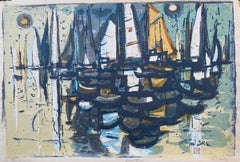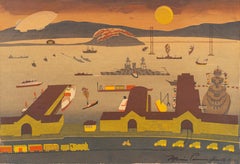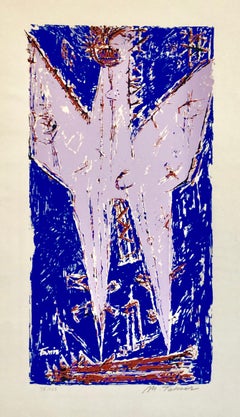Phil Dike Art
to
1
1
1
Overall Height
to
Overall Width
to
1
1
1
1
1
6,857
3,171
2,516
1,217
1
Artist: Phil Dike
SUN GLOW
By Phil Dike
Located in Santa Monica, CA
PHIL DIKE (1906 - 1990)
SUN GLOW . 1960
Color serigraph, edition 25. Signed, numbered and tItled in pencil .
Image 15 x 23 inches. Sheet 16 1/2 x 23 1/2 in...
Category
1960s Modern Phil Dike Art
Materials
Screen
Related Items
'San Francisco Harbor', SFAA, MoMA, de Young Museum, San Francisco Woman Artist
By Marion Osborn Cunningham
Located in Santa Cruz, CA
A panoramic view of the San Francisco docks showing a large destroyer berthed at right, with a view beyond towards Treasure Island and a luminous harvest moon hanging above the hills.
Signed, in screen, lower right 'Marion Cunningham' (American, 1908-1948) and dated 1944.
Paper dimensions: 10.25 x 14.5 inches
Born in Indiana, Marion Osborn Cunningham moved to California in 1911. She first studied art with the American Impressionist, Ruth Heil Emerson, before continuing her education at Santa Barbara City College and receiving her Bachelor of Arts from Stanford University. She subsequently furthered her studies at the California School of the Fine Arts and at the Art Students League in New York City, where she met and married the American abstract artist Ben Cunningham. Returning to San Francisco, she opened a studio on Montgomery Street, the center of San Francisco’s art colony, where she continued to paint and create graphic works for the remainder of her life.
Over the course of a distinguished career, Marion Cunningham exhibited widely and with success, including at the National Serigraph Society, the Association of San Francisco Women Artists, the San Francisco Art Association, the San Francisco Museum of Art Inaugural (1935); the Golden Gate International Exposition (1939); San Francisco Watercolor Show (1939); and her memorial retrospective at the Bakersfield Art Association (1957). She was a member of numerous professional associations including the National Serigraph Society, the Association of San Francisco Women Artists and the San Francisco Art Association. Marion Osborn Cunningham's works may be found in the permanent public collections of museums nationwide including the National Gallery in Washington, DC; New York's Metropolitan Museum of Art and Museum of Modern Art; the Pennsylvania Academy of Fine Arts; the San Francisco Museum of Art; the St. Louis Museum of Art; the Cleveland Museum and the De Young Museum...
Category
1940s Modern Phil Dike Art
Materials
Screen, Paper
1959 Israeli Moshe Tamir Color Modernist Mixed Media Serigraph Phoenix
By Moshe Tamir
Located in Surfside, FL
Abstract Composition, 1959 Silkscreen Lithograph "Phoenix".
This was from a portfolio which included works by Yosl Bergner, Menashe Kadishman, Yosef Zaritsky, Aharon Kahana...
Category
1950s Modern Phil Dike Art
Materials
Lithograph, Screen
Original "Wagon Lits" pop art style serigraph travel by train poster
By Valerio Adami
Located in Spokane, WA
Original “Wagon Lits” serigraph poster by the artist Valerio Adami.
It was printed in France by GrafiCaza (Michel Caza), one of the finest serigraph companies on woven paper—in exce...
Category
1990s American Modern Phil Dike Art
Materials
Screen
H 36 in W 24 in D 0.05 in
La Fete a Honfleur
By Fanch (Francois Ledan)
Located in San Francisco, CA
This artwork, "La Fete a Honfleur" c.1980 is a original colors serigraph on Wove paper by French artist (Fanch) Francois Ledan, born 1949. it is hand signed an...
Category
Late 20th Century Modern Phil Dike Art
Materials
Screen
Pine View
By Virgil Trasher
Located in San Francisco, CA
This artwork titled "Pine View" 1986 in an original color serigraph by American artist Virgil Trasher b.1943. It is hand signed, dated, numbered 220/350 and titled in pencil by the artist. The image size is 22 x 16 inches, sheet size is 28.5 x 22.75 inches. It is in excellent condition.
About the artist:
Virgil Thrasher...
Category
Late 20th Century American Modern Phil Dike Art
Materials
Screen
Original "Think American" USA World War II vintage poster
Located in Spokane, WA
Original poster: For a Country Where We Are Still Masters of Our Own Destinies, Let's Be Truly Thankful. Silk-screened patriotism. This is a poster meant to appeal to the American f...
Category
1940s American Modern Phil Dike Art
Materials
Screen
H 27.25 in W 20 in D 0.05 in
Modernist Silkscreen Screenprint 'El Station, Interior' NYC Subway, WPA Artist
By Anthony Velonis
Located in Surfside, FL
screenprint printed in color ink on wove paper. New York City subway station interior.
Anthony Velonis (1911 – 1997) was an American painter and designer born in New York City who helped introduce the public to silkscreen printing in the early 20th century.
While employed under the federal Works Progress Administration, WPA during the Great Depression, Velonis brought the use of silkscreen printing as a fine art form, referred to as the "serigraph," into the mainstream. By his own request, he was not publicly credited for coining the term.
He experimented and mastered techniques to print on a wide variety of materials, such as glass, plastics, and metal, thereby expanding the field. In the mid to late 20th century, the silkscreen technique became popular among other artists such as Robert Rauschenberg and Andy Warhol.
Velonis was born into a relatively poor background of a Greek immigrant family and grew up in the tenements of New York City. Early on, he took creative inspiration from figures in his life such as his grandfather, an immigrant from the mountains in Greece, who was "an ecclesiastical painter, on Byzantine style." Velonis attended James Monroe High School in The Bronx, where he took on minor artistic roles such as the illustration of his high school yearbook. He eventually received a scholarship to the NYU College of Fine Arts, into which he was both surprised and ecstatic to have been admitted. Around this time he took to painting, watercolor, and sculpture, as well as various other art forms, hoping to find a niche that fit. He attended NYU until 1929, when the Great Depression started in the United States after the stock market crash.
Around the year 1932, Velonis became interested in silk screen, together with fellow artist Fritz Brosius, and decided to investigate the practice. Working in his brother's sign shop, Velonis was able to master the silkscreen process. He reminisced in an interview three decades later that doing so was "plenty of fun," and that a lot of technology can be discovered through hard work, more so if it is worked on "little by little."
Velonis was hired by Mayor LaGuardia in 1934 to promote the work of New York's city government via posters publicizing city projects. One such project required him to go on a commercial fishing trip to locations including New Bedford and Nantucket for a fortnight, where he primarily took photographs and notes, and made sketches. Afterward, for a period of roughly six months, he was occupied with creating paintings from these records. During this trip, Velonis developed true respect and affinity for the fishermen with whom he traveled, "the relatively uneducated person," in his words.
Following this, Velonis began work with the Public Works of Art Project (PWAP), an offshoot of the Civil Works Administration (CWA), where he was assigned to serve the different city departments of New York. After the formation of the federal Works Progress Administration, which hired artists and sponsored projects in the arts, he also worked in theater.
Velonis began working for the federal WPA in 1935. He kept this position until 1936 or 1938, at which point he began working in the graphic art division of the Federal Art Project, which he ultimately led. Under various elements of the WPA program, many young artists, writers and actors gained employment that helped them survive during the Depression, as well as contributing works that created an artistic legacy for the country.
When interviewed in December 1994 by the Library of Congress about his time in the WPA, Velonis reflected that he had greatly enjoyed that period, saying that he liked the "excitement" and "meeting all the other artists with different points of view." He also said in a later interview that "the contact and the dialogue with all those artists and the work that took place was just invaluable." Among the young artists he hired was Edmond Casarella, who later developed an innovative technique using layered cardboard for woodcuts.
Velonis introduced silkscreen printing to the Poster Division of the WPA. As he recalled in a 1965 interview: "I suggested that the Poster division would be a lot more productive and useful if they had an auxiliary screen printing project that worked along with them. And apparently this was very favorably received..."
As a member of the Federal Art Project, a subdivision of the WPA, Velonis later approached the Public Use of Arts Committee (PUAC) for help in "propagandizing for art in the parks, in the subways, et cetera." Since the Federal Art Project could not be "self-promoting," an outside organization was required to advertise their art more extensively. During his employment with the Federal Art Project, Velonis created nine silkscreen posters for the federal government.
Around 1937-1939 Velonis wrote a pamphlet titled "Technical Problems of the Artist: Technique of the Silkscreen Process," which was distributed to art centers run by the WPA around the country. It was considered very influential in encouraging artists to try this relatively inexpensive technique and stimulated printmaking across the country.
In 1939, Velonis founded the Creative Printmakers Group, along with three others, including Hyman Warsager. They printed both their own works and those of other artists in their facility. This was considered the most important silkscreen shop of the period.
The next year, Velonis founded the National Serigraph Society. It started out with relatively small commercial projects, such as "rather fancy" Christmas cards that were sold to many of the upscale Fifth Avenue shops...
Category
1980s American Modern Phil Dike Art
Materials
Screen
The Umbrellas (Blue) (FRAMED - BLACK OR WHITE - YOU CHOOSE - FREE US SHIPPING)
By Christo and Jeanne-Claude
Located in Kansas City, MO
Christo
The Umbrellas (Blue) (FRAMED - either black or white frame - you choose)
Lithoserigraph
Year: 1991
Size: 14.6 × 16.4 on 19.1 × 19.9 inches
Framed: 20.5 x 20.5 x 2.5 inches
Pr...
Category
1990s Modern Phil Dike Art
Materials
Lithograph, Screen
H 20.5 in W 20.5 in D 2.5 in
Untitled Landscape II
By Claudia Keller
Located in Kansas City, MO
Claudia Keller
Untitled Landscape II
Color Silkscreen
Year: 1985
Signed, dated, numbered or inscribed
Edition: 180
Size: 19.5 × 18.5 on 27.3 × 23.4 in...
Category
1980s Modern Phil Dike Art
Materials
Screen
'Deckchairs on the Beach', Hand-Colored Screenprint
By Margie Dickson
Located in Santa Cruz, CA
Signed lower right, 'Margie Dickson' (American, 20th century) and dated 1990; additionally inscribed lower center 'hand colored screen print' with number and limitation, '5/20' and titled lower left...
Category
1990s Modern Phil Dike Art
Materials
Screen, Paper
Pair of serigraphs, Twin Lake and Lake View
By Virgil Trasher
Located in San Francisco, CA
These artwork titled "Twin Lake and Lake view" 1986 are two original color serigraphs on different papers by American artist Virgil Trasher b.1943. One is ...
Category
Late 20th Century American Modern Phil Dike Art
Materials
Screen
East Cove
By Virgil Trasher
Located in San Francisco, CA
This artwork titled "East Cove" 1987 in an original color serigraph by American artist Virgil Trasher b.1943. It is hand signed, inscribed A.P and titl...
Category
Late 20th Century American Modern Phil Dike Art
Materials
Screen
Phil Dike art for sale on 1stDibs.
Find a wide variety of authentic Phil Dike art available for sale on 1stDibs. You can also browse by medium to find art by Phil Dike in screen print and more. Much of the original work by this artist or collective was created during the 1960s and is mostly associated with the modern style. Not every interior allows for large Phil Dike art, so small editions measuring 23 inches across are available. Customers who are interested in this artist might also find the work of Richard Florsheim, Samuel Chamberlain, and Virgil Trasher. Phil Dike art prices can differ depending upon medium, time period and other attributes. On 1stDibs, the price for these items starts at $575 and tops out at $575, while the average work can sell for $575.


